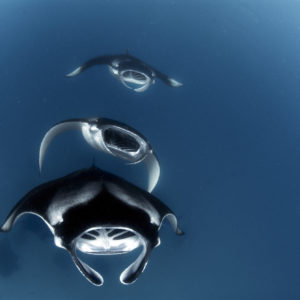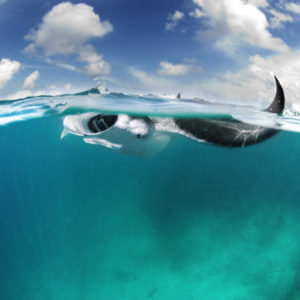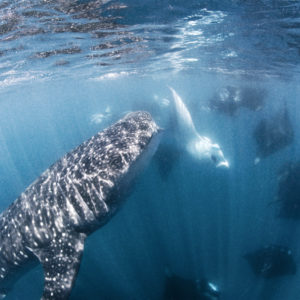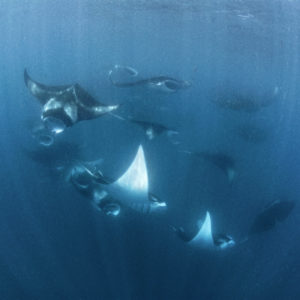The largest of all rays exhibits an almost uncanny grace underwater. Feeding mostly on plankton, which they guide into their mouths using their hornlike cephalic fins (fleshy projections on either side of the mouth), they pose no threat to humans. Divers are drawn to manta hotspots around the world to observe and film them. The Manta Trust’s ongoing research projects are helping to create protection for this close relative of the sharks. Ordinary snorkellers and divers can contribute valuable photo ID data and join Manta Trust programs to support their efforts to preserve this intriguing animal. The Trust run by my charismatic friend Guy Stevens is committed to their vision of providing a sustainable future for the oceans where manta rays thrive in healthy, diverse marine ecosystems. We are very glad to support this.
“Hanifaru Bay, where plankton concentrations are particularly high, hundreds of rays will assemble and form a feeding vortex called cyclone feeding. It is normally very difficult to get so close to these graceful creatures but I was priviledged that the animals came so close to me that I could get such shots with the rays only centimetres away from me. This behaviour only happens a dozen or so times a year and this phenomena is not known to occur anywhere else on the planet.”
I had the pleasure to work with Guy at Hanifaru Bay in the Maldives who helped me to get these images. Guy’s conservation efforts in the Maldives have led to the creation of several Marine Protected Areas (MPA’s) at key manta aggregation sites, most notably at Hanifaru Bay, where his work was featured in the National Geographic Magazine in July 2009 in conjunction with my good friend and the supremely talented Tom Peschak. in his words he describes this phenonema…
From May through November, when the lunar tide pushes against the Indian Ocean’s southwestern monsoon current, a suction effect pulls tropical krill and other plankton from deep water up to the surface. The current sweeps the krill into the cul-de-sac of Hanifaru Bay. If the krill stayed at the surface, they’d wash over the bay’s coral walls and out to the safety of the open sea. But they can’t. Instinct forces them to dive away from daylight. When they do, they get trapped deep in the bowl. In just a few hours a massive concentration of plankton builds up, a swarm so thick it turns the water cloudy.
Cue Manta birostris. “Just after high tide you’ll see a few manta rays turn up,” says Guy Stevens, a British marine biologist who’s been researching the Maldives mantas for the past three years. “Then poof, a whole group will move in, and you’ll get as many as 200 feeding for two to four hours in a bay no bigger than a soccer field.”
These massive fish (the wingspans of Maldives mantas can reach 12 feet) are dynamic filter feeders, shoveling their shoe-box mouths through krill like threshers through wheat, inhaling prey. They barrel roll when they hit a rich patch, somersaulting backward to stay in the hot spot. They chain feed, following each other in a train of open maws.
In the tight confines of Hanifaru Bay, mantas must expand their repertoire, and Stevens has identified maneuvers rarely seen by scientists. When 50 or more fish chain feed in the bay, something extraordinary happens. The head of the line catches the tail, and the chain spins into a vortex. “We call that cyclone feeding,” says Stevens. “When you get more than a hundred mantas doing that, they start to spiral out. When the chain breaks down, you get chaos feeding.” The stately dance in the milky waters turns into a free-for-all, with hundreds of mantas bumping into each other. Adding to the confusion are whale sharks—languid, plankton-eating giants, each about the size of a 40-foot shipping container—that show up to share the spoils. Within hours the plankton run out, the feast winds down, and the mantas plow the bay’s sandy bottom with their cephalic fins to throw hidden prey back into the water column.
Generations ago those hornlike cephalic fins earned mantas the name devilfish. Their terrifying size and bat shape fed an aura of mystery and menace, and mantas were vilified as ferocious monsters. That changed in the 1970s, when scuba divers found mantas to be gentle creatures. Sometimes they even permitted humans to catch joyrides on their broad backs.
Because of their accommodating nature, mantas today have achieved the dubious status of dive-tourism attractions, luring humans to swim with them in closer-than-optimum quarters. For a species considered near threatened, however, this newfound popularity could literally be a lifesaver. Mantas, with their slow reproductive rate, are vulnerable to overfishing, so a robust tourist trade could give local communities an economic incentive to conserve the fish rather than kill them. It’s a delicate balance, though—too many humans could drive mantas out of feeding grounds like Hanifaru Bay.
To avoid that, Stevens has proposed turning the bay into a marine sanctuary. A new Maldives president has vowed to strengthen the archipelago’s marine protections, but his government has so far been slow to respond to Stevens’s idea. “I’m not ruling out declaring Hanifaru a marine-life sanctuary. But we need to increase our ability to enforce existing environmental laws before creating new protected areas,” says Environment Minister Mohamed Aslam.
Meanwhile, scientific knowledge about mantas remains surprisingly thin. Only last year a leading expert proposed splitting the species in two: smaller resident mantas, like those in the Maldives that remain near shore, and larger transient mantas (with wingspans as great as 22 feet) that roam the world’s tropical and semitropical oceans. And researchers are just beginning to learn more about those cephalic fins. “When you approach a manta, it will unroll a cephalic fin and wave it back and forth as if it’s scanning,” says Robert Rubin, a California-based marine biologist who’s studied mantas in Mexico for 20 years. “Mantas are essentially flat sharks, and we know some sharks have electrical receptors in their faces. The hypothesis is that mantas use those fins to pick up electrical signals from other animals moving in the water.”
In the Maldives, Stevens continues to catalog the local animals. (He’s identified more than 1,500 individuals by their unique spot patterns.) His data also record the exact timing of the feedings, information that would be of great value to the local guide industry. Stevens hears the clock ticking, and he is scrambling to organize a self-policing regime among resorts and local guides before dive tourists overrun Hanifaru. “We don’t want to ruin what we’ve got here,” he says. If his plan works, Hanifaru Bay will remain a sanctuary for cyclone-feeding manta rays, with just enough room for whale sharks, and humans as well.







